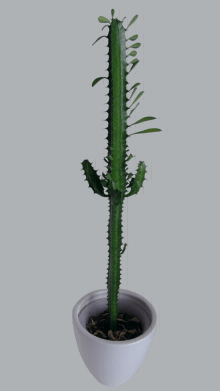Euphorbia trigona
| Euphorbia trigona | |
|---|---|
 | |
| A potted Euphorbia trigona | |
| Scientific classification | |
| Kingdom: | Plantae |
| (unranked): | Angiosperms |
| (unranked): | Eudicots |
| (unranked): | Rosids |
| Order: | Malpighiales |
| Family: | Euphorbiaceae |
| Genus: | Euphorbia |
| Species: | E. trigona |
| Binomial name | |
| Euphorbia trigona Mill. | |
Euphorbia trigona (also known as African milk tree,[1] cathedral cactus,[1] Abyssinian euphorbia,[2] and high chaparall[3][4]) is a perennial plant that originally comes from Central Africa. It has an upright stem that is branched into three or four sides. The stem itself is dark green with V-shaped light green patterns. The about 5mm long thorns are placed in pairs of two on the stem's ridges. The drop shaped leafs grows from between the two thorns on each ridge. The plant has never been known to flower,[5][6] and is possibly a hybrid.[6] As with many other Euphorbia species, the latex from the plant is venomous and can cause skin irritations.[6]
Uses
The plant is only known in human cultivation and is commonly used as a house plant.[6] It is used as a ritual plant and a hedge in Gabon.[6]
References
- ↑ 1.0 1.1 Timothy K. Broschat, Alan W. Meerow. Betrock's Reference Guide to Florida Landscape Plants. Betrock Information Systems, 1991. p. 123. ISBN 9780962976100
- ↑ Thomas C. Fuller. Poisonous Plants of California. University of California Press, 1986. p. 372. ISBN 9780520055698
- ↑ http://www.ne.se/lang/trekantseuforbia (Swedish)
- ↑ http://www.krukväxter.com/HighChaparall.php (Swedish)
- ↑ James Cullen, Sabina G. Knees, H. Suzanne Cubey. The European Garden Flora Flowering Plants: A Manual for the Identification of Plants Cultivated in Europe, Both Out-of-Doors and Under Glass. Cambridge University Press, 2011. p. 498. ISBN 9780521761550
- ↑ 6.0 6.1 6.2 6.3 6.4 Medicinal Plants, Volume 1. PROTA, 2008. p. 260. ISBN 9789057822049